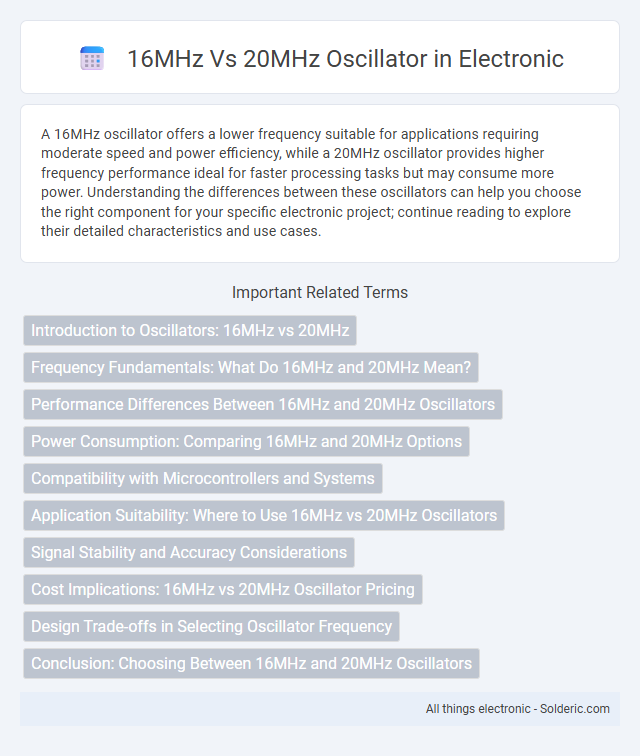A 16MHz oscillator offers a lower frequency suitable for applications requiring moderate speed and power efficiency, while a 20MHz oscillator provides higher frequency performance ideal for faster processing tasks but may consume more power. Understanding the differences between these oscillators can help you choose the right component for your specific electronic project; continue reading to explore their detailed characteristics and use cases.
Comparison Table
| Feature | 16MHz Oscillator | 20MHz Oscillator |
|---|---|---|
| Frequency | 16 million cycles per second | 20 million cycles per second |
| Clock Speed | 16 MHz | 20 MHz |
| Power Consumption | Lower, suitable for low-power applications | Higher, increased power needs |
| Timing Accuracy | Standard precision | Higher precision in time-critical applications |
| Processing Speed | Moderate | Faster execution of instructions |
| Heat Generation | Less heat | More heat generated |
| Application | Embedded systems, microcontrollers, low-speed devices | High-speed processors, performance-critical hardware |
| Cost | Generally lower | Generally higher |
Introduction to Oscillators: 16MHz vs 20MHz
A 16MHz oscillator operates at a frequency of 16 million cycles per second, providing stable clock signals commonly used in microcontrollers and embedded systems, while a 20MHz oscillator runs faster at 20 million cycles per second, offering higher processing speeds for more demanding applications. The choice between a 16MHz and 20MHz oscillator directly affects your device's timing accuracy, power consumption, and overall performance, with the 20MHz option typically generating more heat and consuming slightly more power. Selecting the appropriate oscillator frequency ensures optimal balance between speed and efficiency tailored to your specific electronic circuit requirements.
Frequency Fundamentals: What Do 16MHz and 20MHz Mean?
16MHz and 20MHz oscillators indicate the frequency at which their crystal vibrates to generate a stable clock signal, with 16MHz producing 16 million cycles per second and 20MHz offering 20 million cycles per second. The higher frequency of the 20MHz oscillator allows for faster processing speeds and improved timing accuracy in digital circuits, directly impacting system performance and power consumption. Your choice between 16MHz and 20MHz depends on the specific timing requirements and operational speed of your electronic application.
Performance Differences Between 16MHz and 20MHz Oscillators
A 20MHz oscillator offers higher clock speed, resulting in faster instruction execution and improved overall system performance compared to a 16MHz oscillator. This increase in frequency enhances processing throughput in microcontrollers and digital circuits, supporting more demanding applications and reducing latency. However, the 20MHz oscillator may generate more electromagnetic interference (EMI) and consume slightly more power than the 16MHz counterpart.
Power Consumption: Comparing 16MHz and 20MHz Options
A 16MHz oscillator typically consumes less power than a 20MHz oscillator due to its lower frequency, resulting in reduced switching activity within the circuit. Choosing a 16MHz option can enhance your device's energy efficiency, especially in battery-powered applications where power consumption is critical. The 20MHz oscillator, while offering higher performance, generally leads to increased power draw, which may not be ideal for low-power designs.
Compatibility with Microcontrollers and Systems
A 16MHz oscillator is widely compatible with most microcontrollers, including popular models like the Arduino Uno (ATmega328P), which often use this frequency as a standard clock source, ensuring stable operation and easy integration. In contrast, a 20MHz oscillator provides higher clock speed benefits but may require microcontrollers with flexible clock input ranges, such as certain ARM Cortex-M processors, to handle increased timing demands without instability. Selecting between a 16MHz and 20MHz oscillator depends on the specific microcontroller's maximum allowable frequency and the system's timing requirements for optimal compatibility and performance.
Application Suitability: Where to Use 16MHz vs 20MHz Oscillators
16MHz oscillators are ideal for microcontroller applications requiring lower power consumption and moderate clock speeds, such as Arduino boards and embedded systems operating within standard timing protocols. 20MHz oscillators suit performance-intensive applications demanding higher processing speeds and more precise timing, including advanced communication devices or high-frequency data processing units. Your choice depends on balancing the need for power efficiency against processing speed and timing accuracy requirements of the specific application.
Signal Stability and Accuracy Considerations
A 20MHz oscillator typically provides higher frequency precision and better signal stability compared to a 16MHz oscillator, making it more suitable for applications requiring exact timing. The increased frequency allows for finer resolution in clock generation, reducing jitter and improving synchronization in communication systems. However, 16MHz oscillators often consume less power and generate less heat, which can be advantageous in power-sensitive environments despite slightly lower signal accuracy.
Cost Implications: 16MHz vs 20MHz Oscillator Pricing
A 16MHz oscillator generally offers lower pricing compared to a 20MHz oscillator due to simpler manufacturing processes and higher production volumes. The slight frequency increase to 20MHz often results in increased material and calibration costs, reflecting in a higher unit price. For cost-sensitive projects, choosing a 16MHz oscillator can optimize budget without significantly compromising performance.
Design Trade-offs in Selecting Oscillator Frequency
Selecting between 16MHz and 20MHz oscillators involves trade-offs in power consumption, signal integrity, and system timing accuracy. A 20MHz oscillator enables higher processing speeds and improved data throughput but can increase electromagnetic interference and power dissipation. Conversely, a 16MHz oscillator offers lower power usage and reduced noise, optimizing battery life and stability in low-power embedded applications.
Conclusion: Choosing Between 16MHz and 20MHz Oscillators
Choosing between a 16MHz and 20MHz oscillator depends on your application's performance and power requirements. A 20MHz oscillator provides faster clock speeds, ideal for high-performance microcontrollers and time-critical tasks, while a 16MHz oscillator offers lower power consumption and is sufficient for most embedded systems. Evaluating your system's processing speed needs and energy efficiency goals ensures the most suitable oscillator choice.
16MHz vs 20MHz oscillator Infographic

 solderic.com
solderic.com